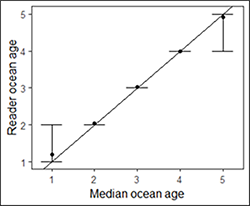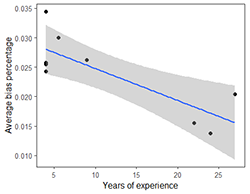Bias in Age Estimates
Last modified on Aug 15, 2022
To examine bias, we used median age of 10 experienced readers as a proxy for the "true" age. This is reasonable because there was 100% agreement between the median age and 22 known-age scales and because experienced readers had higher agreement with the median age than any other age, including the original ages. Bias was defined as the difference between reader age and the median age. We calculated the percent of scales where the reader age was older (age was overestimated), the same, and younger (age was underestimated) and compared these percentages among groups.
Familiarity with stock
Familiar stocks were scales processed in a reader's area office or stocks where the reader measured more than 900 scales, or were unfamiliar. There was no difference in reader bias between familiar and unfamiliar stocks (Table 1).
Marine age
Bias in marine age estimates was towards common ages. Readers tended to under-estimate age for older fish about 8% of the time and over-estimate age for young fish as older about 5% of the time (Figure 4).
Years of experience
Bias with years of reader experience (Figure 5). Note that readers had 10 or less or more than 20 years of experience.
Table 1. Percent of scales with fish age that was younger than median age, the same (no difference), or older than median age of 6,074 scales read by 10 people sampled from Karluk, Copper, Kuskokwim, Nushagak, and Stikine rivers, return years 1980-2015. The median age was of 10 ages from readers who were experienced with Chinook salmon scale age estimation. Stocks were considered familiar if they from their home office or if the reader had measured more than 900 scales, otherwise the stock was considered unfamiliar.
| Scale pattern familiarity | Younger than median | No difference | Older than median |
|---|---|---|---|
| Familiar | 6.1% | 90.6% | 3.3% |
| Unfamiliar | 7.6% | 88.5% | 3.6% |


